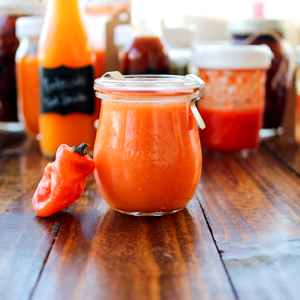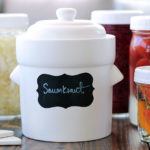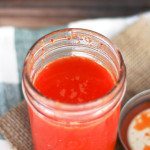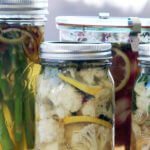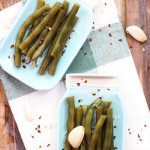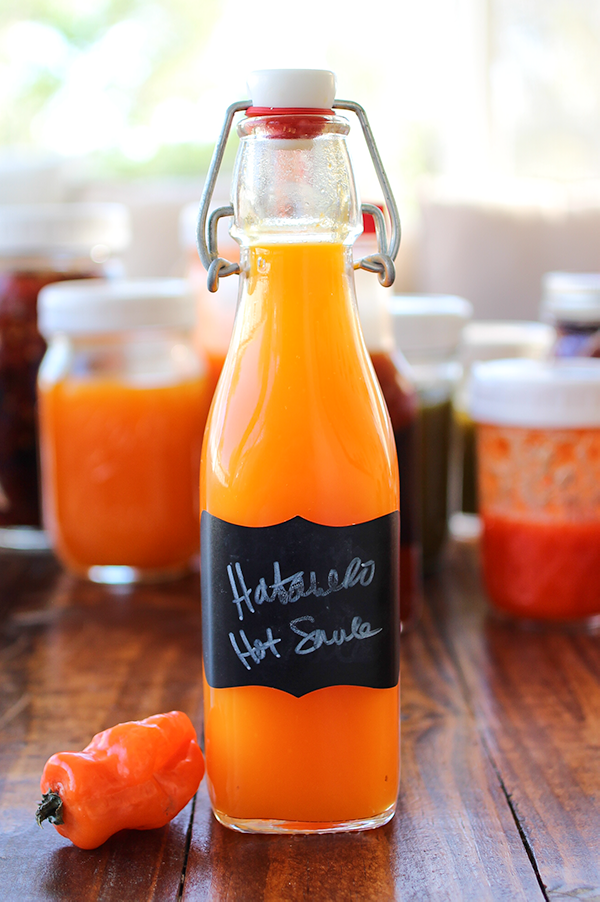
Habanero peppers, bell peppers and garlic are fermented in saltwater to create a spicy, Habanero Hot Sauce that’s rich in flavor and delicious put on top of anything you want to add some heat to.
Fermentation brings out all the flavor in peppers. The heat, the rich umami flavor and tanginess develops the longer they ferment. Nothing compares to aged fermented hot sauce.
Ferment some hot sauce and then stash a bottle in the back of the fridge, forget about it for awhile and then discover it again months later and you’ll be in for a treat. I get excited when I find hot pepper sauce in the back of my fridge, because the flavor is amazing.
Lacto-Fermentation
This Habanero Hot Sauce recipe is made using lacto-fermentation. Fermented hot sauce is richer in flavor than something you buy from the store. It’s free of additives and preservatives and its healthy for you, because it’s alive with probiotic bacteria.
Lacto-fermentation is the oldest form of food preservation in the world. It involves only salt, water and vegetables. The salt water brine creates an anaerobic environment (free of oxygen) where only lactobacillus bacteria can survive. The lactobacillus bacteria act as a preservative, keeping harmful bacteria from living in the ferment.
The lactic acid bacteria present give the hot sauce it’s tangy, rich flavor.
How to choose hot peppers for habanero hot sauce
When making fermented foods like hot sauce, choose the freshest ingredients.
Choose peppers that are firm and shiny
The peppers should be firm and have a shiny skin. Get them from a farmer’s market if you can’t find them in a local store or grow some yourself.
Use organic when available
Choose organic peppers that are free of pesticides when available. Pesticides are not good for your health and are not good for fermentation either. They can disrupt the process, so choose organic when possible or wash conventional produce with a veggie wash or a vinegar soak before using them.
How to handle hot peppers
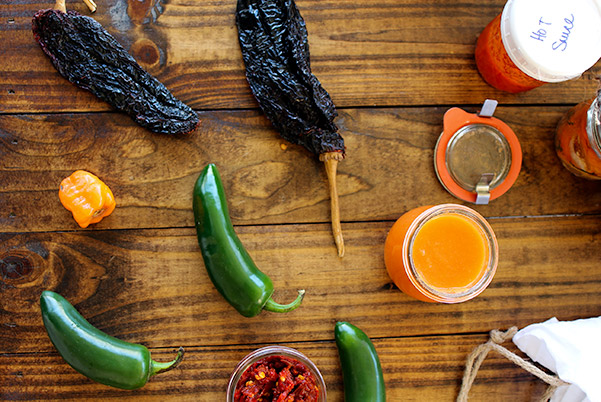
Use gloves when handling hot peppers
The capsicum in hot peppers can literally make your skin burn if not handled properly. You don’t want to handle these peppers without gloves.
Clean tools right after you use them
Make sure to clean your cutting board and tools right after you use them to chop your hot peppers, because it can easily transfer to your hands that way too.
Once it gets on your skin, it can take almost a full day to stop burning. I’ve had burning finger tips for a whole day and tried everything to stop it. Only time lessens the burn. You definitely don’t want to get it into your eyes or other sensitive parts. That’s no fun at all.
So, please use gloves.
Tools you need to make habanero hot sauce
To make Habanero Hot Sauce you’ll need:
- 1 quart size mason jar
- Cutting board & knife
- Mineral salt (sea salt, Himalayan or other mineral salt)
- Purified water
- Gloves
- Fresh ingredients
Clean your tools and jars with soapy water before using them. They just have to be clean, meaning free from dirt, not sterilized. Sterilizing jars and tools is not necessary when fermenting, because it kills all the bacteria on the surface. That’s not necessary and may even be harmful.
What to expect when fermenting habanero hot sauce
Habaneros, bell peppers and garlic will be fermented in a saltwater brine for 10-14 days.
For the first day or two the brine will be clear. About 3 days into fermentation the brine will get cloudy. This is a good thing. It means the lactic-acid bacteria are doing their job.
After 10-14 days you can blend it all up into a hot sauce and place it in a glass container to use. You can store it in cold storage and let it ferment longer to develop the flavors more or in the refrigerator for several months.
You can let it ferment for more than 14 days for more flavor.
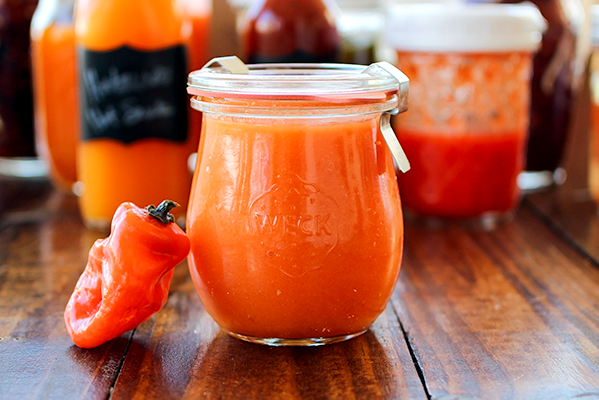
Habanero Hot Sauce Recipe
This recipe is simple and flexible. Orange bell peppers add a little sweetness and lessen the heat while keeping the beautiful orange color. You can omit the bell peppers entirely to make it extra spicy or use a combination of spicy peppers for this hot sauce.
- 2-3 habanero peppers chopped in half
- 2 orange bell peppers
- 2 cloves of garlic
- Basic Brine: 2 cups of water + 1 tablespoon of salt
- Make the basic brine by combining 2 cups of water with 1 tablespoon of salt. Set aside. (You may need to warm the water up a little for the salt to dissolve.
- Chop up the habaneros, orange bell peppers and garlic and add it to the mason jar. Fill the jar to the shoulder.
- Add the basic brine to the jar until the peppers are covered. Leave an inch of space from the top to avoid spills during fermentation.
- Optionally: Add a fermentation weight and an airlock lid if you have them.
- If you're not using an airlock, cover the jar loosely with the lid so gas can escape while it's fermenting.
- Set on the counter away from direct sunlight for 10-14 days.
- When it's done fermenting, strain the pepper mixture from the brine. Set the brine aside.
- Pour the pepper mixture into a blender, turn it on medium and slowly pour the brine into the blender until you get the thickness/ consistency you like.
- Pour the hot sauce into a jar or bottle and store in the refrigerator. Hot sauce will last up to a year in the fridge.
- If you have leftover brine you can mix it with vinegar to make a Tobasco style hot sauce.
Make this Habanero Hot Sauce while hot peppers are in season and use it to warm you up in the coming cool months.
Happy Fermenting!
Danielle
